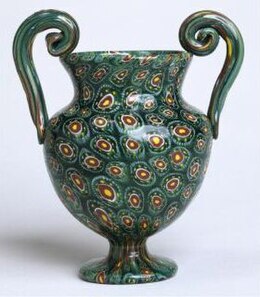Our website is made possible by displaying online advertisements to our visitors.
Please consider supporting us by disabling your ad blocker.
Millefiori

Millefiori (Italian: [ˌmilleˈfjoːri]) is a glasswork technique which produces distinctive decorative patterns on glassware. The term millefiori is a combination of the Italian words "mille" (thousand) and "fiori" (flowers).[1] Apsley Pellatt in his book Curiosities of Glass Making was the first to use the term "millefiori", which appeared in the Oxford English Dictionary in 1849; prior to that, the beads were called mosaic beads. While the use of this technique long precedes the term "millefiori", it is now most frequently associated with Venetian glassware.[2][3]
Since the late 1980s, the millefiori technique has been applied to polymer clay and other materials.[4] As the polymer clay is quite pliable and does not need to be heated and reheated to fuse it, it is a much easier medium in which to produce millefiori patterns than glass.[5]
- ^ "Millefiori Beads". Archived from the original on 2009-03-01. Retrieved 2009-03-11.
- ^ Egglezos, Panos (January 31, 2012). "How It's Made - Millefiori Glass Paperweights" (Video). How It's Made. Discovery Channel. Archived from the original on 2021-12-12. Retrieved March 21, 2019 – via YouTube.
- ^ Struble, Karen. "Millefleur glass paperweight ...and more!". Retrieved March 21, 2019 – via Pinterest.
- ^ DiDominicis, Jill. "Polymer clay: a modern medium comes of age" (PDF). Ornamen Magazine. Retrieved May 1, 2018.
- ^ "Millefiori technique in clay".
Previous Page Next Page


